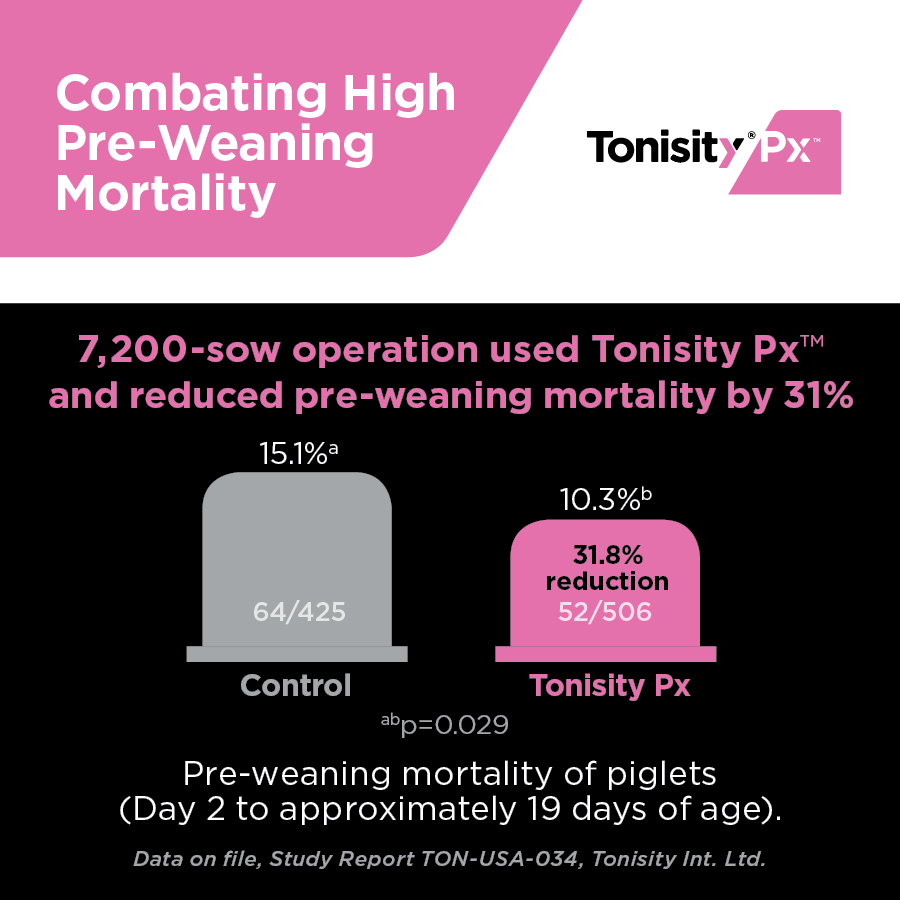 For today’s swine producer, efficiency is everything. It drives profitability and is a key success indicator if operations are to remain competitive in the current market. Because of this, the industry has come a long way in finding opportunities for improved efficiency – especially in the breeding herd.
For today’s swine producer, efficiency is everything. It drives profitability and is a key success indicator if operations are to remain competitive in the current market. Because of this, the industry has come a long way in finding opportunities for improved efficiency – especially in the breeding herd.
Since 2000, U.S. pork production has climbed more than 40 percent with fewer breeding animals, according to U.S. Department of Agriculture data. Today’s sow produces 20 percent more pigs per litter than it did in 2000.
But efficiencies in the U.S. breeding herd, like increased litter sizes, can come at a cost. The standard percentage that farrowing operations and veterinarians discuss when they tackle the challenges of pre-weaning mortality is 15 percent. As the needle continues to rise on the number of pigs a sow farrows each year, producers have an opportunity to lower their pre-weaning mortality rate to improve profitability.
The National Pork Board’s annual Pork Industry Productivity Analysis tracks the performance of all swine production phases for about 35 percent of the U.S. sow herd. The analysis revealed the 15 percent pre-weaning mortality standard is not far off. Furthermore, the report found pre-weaning mortality has held fairly stable since 2011.
Over the six years of the study’s data, pre-weaning mortality for the top 25 percent for each production indicator on average has ranged as high as 13.7 percent in 2014 to a low of 13 percent in 2013. For 2016, the data reflects an unchanged figure of 13.2 percent with the previous year.
Saving pigs has minimal added cost
The math is simple in determining the economic impact of pre-weaning mortality to your farm, says Derald Holtkamp, DVM, M.S., Iowa State University, College of Veterinary Medicine. “On a 1,000-head sow farm, if a producer could wean one extra pig per sow per year, it could result in an extra $40,000 at $40 per weaned pig.”
Saving pigs comes at minimal added cost, therefore creating a lower cost per pig. Holtkamp explains the pigs weaned on the sow farm have very little to do with the expenses of the operation. “The costs depend primarily on how many sows they have, not how many pigs are weaned. If you look closely at the fixed and variable costs on the sow farm, what you find is if you improve efficiency by improving pre-weaning mortality, the extra pigs weaned results in extra revenue but little additional cost in saving pigs.”
Nutrition critical in first few days of life
It has been established the increase in litter size correlates with a reduction in birth weight. Therefore, getting the piglet adequate nutrition is critical in the first few days of life. However, the challenge often is getting young pigs to seek out those nutrients.
Keith Aljets, DVM, Veterinary Medical Center in Williamsburg, Iowa, says while the industry is seeing the trend of more pigs born alive, many are starving because there is not adequate teat space available to raise all the piglets. “Supplementation of these piglets can help them survive,” he says.
Aljets says producers he works with are looking for products to supplement piglets. The only product he has had success with is Tonisity Px™, the first isotonic protein drink for pigs.
“I think it’s remarkable how the taste and smell are so appealing to pigs,” says Aljets. “Having a product that young pigs will consume in a farrowing crate on day two is amazing, especially when you watch pigs turn away from other products you put in the crate.”
The first time Aljets used Tonisity Px, he put it in a tray in a farrowing crate and watched 2- to 3-day-old pigs put their noses in and drink. “This product is the first one I’ve seen that breaks the barrier between sucking and eating,” he says. “It teaches pigs to get nutrition from a feeder, not just the sow.”
Research shows reduced mortality, increased gain
A research study at a 7,200-sow farrow-to-finish Iowa operation investigated the effects of Tonisity Px supplementation on nursing pigs. Piglets in the study were weighed at day two, day eight, at weaning and 20 days post-weaning.
Pre-weaning mortality was reduced by 31.8 percent in pigs that received Tonisity Px – increasing a piglet’s chance of survival by 155 percent. Additionally, pigs that consumed the product gained around 10 percent more weight than the control groups at all weigh-in periods, which gave them an advantage as they moved through the production cycle.
“Tonisity Px clearly shows promise as a non-drug strategy for getting piglets off to a strong start and reducing death loss,” says Aljets.
Establish a goal
Holtkamp encourages producers to set an achievable pre-weaning mortality goal. He points to the PigCHAMP benchmark reports, which reveal the top 10 percent of operations in 2017 achieved a pre-weaning mortality rate of around 9.6 percent. “That’s an achievable goal,” he says.
“A producer with a pre-weaning mortality rate higher than 10 percent should do a cost-benefit analysis of their operation. Producers often don’t dig deep enough into why their operation performs as it does and they could be leaving money on the table.”
A cost-benefit analysis, which is the process of weighing all costs and benefits of an intervention, provides producers with an informed decision when considering a new technology. If the desired outcome is improvement in pre-weaning mortality, then the producer needs to set a goal, determine how much it will cost to achieve that goal and the change in profit it could bring to the operation.
“A cost-benefit analysis is an invaluable tool to determine if an animal-health intervention is financially viable,” states Holtkamp. “Going through the process is time well spent.”